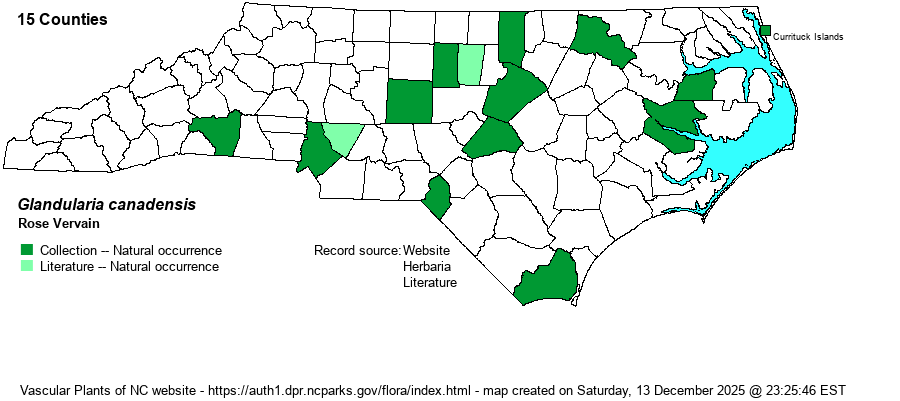| Author | (L.) Nuttall | |
| Distribution | Widely scattered in the Coastal Plain and Piedmont. As this species is planted and can escape, how many of these records may refer to non-natural populations is not known. Weakley (2020) and the Digital Atlas of the Virginia Flora considers the records in NC and VA of Uncertain status; however, Weakley (2022) now shows NC and VA as within the normal range as "native".
This is a Southern Great Plains and Southern Mississippi species, ranging east mainly to that river, but sporadically east to NC and FL. | |
| Abundance | Very rare to rare in the Coastal Plain and Piedmont, and apparently declining. The NCNHP's State Rank of S1? is perhaps still appropriate, despite 13 counties with specimen records that suggest a rank of S1S2 or S2; however, most of the collections are before 1960. At any rate, it is a Watch List species and deserves to be on the Significantly Rare list, if we can be reasonably certain it is truly native in NC. | |
| Habitat | This is a species of open, dry country. It is normally found in prairies, but in our area it grows on roadsides, in sandhills, and in glades and barrens. Some sites are clearly over high pH soils. | |
| Phenology | Blooms from March to May, and fruits shortly after flowering. | |
| Identification | This is a leaning to more often decumbent plant, growing to about 8-12 inches long, often forming patches of plants. The stem leaves are quite variable, but they are opposite and usually toothed to deeply cut into lobes, with otherwise serrated margins. Each leaf is only 1-1.5 inches long and nearly as wide, and in general an ovate shape. At the ends of some of the ascending branches are spikes of flowers, each spike about 4 inches long, with numerous medium-sized rose-pink flowers. Each flower has a narrow corolla tube, and 5 flaring lobes, each with a distinct notch in the apex and squared off at the apex; a spread flower is about 1/2-inch across. Even though the flowers are arranged in a spike, the flowers are spreading enough that when in bloom, the flower cluster is usually ball-shaped or rounded, quite attractive. As the plants often grow in dense stands, a patch in bloom will catch your attention at quite a distance. There are numerous species of Verbena in NC, most being exotic, so check with various references for identification, though this species is the only one that is prostrate, flowers about 1/2-inch across, and leaves dissected but not into very narrow segments -- as is the exotic Glandularia aristigera (formerly V. tenuisecta). | |
| Taxonomic Comments | This species was known for most of the 20th Century as Verbena canadensis.
| |
| Other Common Name(s) | Rose Verbena, Creeping Vervain, Rose Mock Vervain | |
| State Rank | S1? [S1S2] | |
| Global Rank | G5 | |
| State Status | W7 | |
| US Status | | |
| USACE-agcp | | |
| USACE-emp | | |

